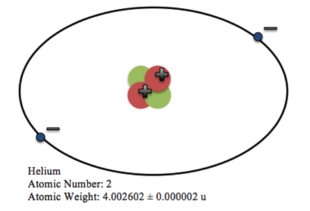
In the field of cryogenics, helium [He] is utilized for a variety of reasons. The combination of helium’s extremely low molecular weight and weak interatomic reactions yield interesting properties when helium is cooled below its critical temperature of 5.2 K to form a liquid. Even at absolute zero (0K), helium does not condense to form a solid under ambient pressure. In this state, the zero point vibrational energies of helium are comparable to very weak interatomic binding interactions, thus preventing lattice formation and giving helium its fluid characteristics.[1] Within this liquid state, helium has two phases referred to as helium I and helium II. Helium I displays thermodynamic and hydrodynamic properties of classical fluids, along with quantum characteristics. However, below its lambda point of 2.17 K, helium transitions to He II and becomes a quantum superfluid with zero viscosity.[2]
Under extreme conditions such as when cooled beyond Tλ, helium has the ability to form a new state of matter, known as a Bose–Einstein condensate (BEC), in which the atoms virtually lose all their energy. Without energy to transfer between molecules, the atoms begin to aggregate creating a volume of equivalent density and energy.[3] From observations, liquid helium only exhibits super-fluidity because it contains isolated islands of BECs, which have well-defined magnitude and phase, as well as well-defined phonon–roton (P-R) modes.[4] A phonon refers to a quantum of energy associated with a compressional wave such as the vibration of a crystal lattice while a roton refers to an elementary excitation in superfluid helium. In the BEC’s, the P-R modes have the same energy, which explains the zero point vibrational energies of helium in preventing lattice formation.[5]
When helium is below Tλ, the surface of the liquid becomes smoother, indicating the transition from liquid to superfluid.[6] Experiments involving neutron bombardment correlate with the existence of BEC’s, thereby confirming the source of liquid helium’s unique properties such as super-fluidity and heat transfer.[6][7]

Though seemingly paradoxical, cryogenic helium systems can move heat from a volume of relatively low temperature to a volume of relatively high temperature.[8] Though this phenomenon appears to violate the second law of thermodynamics, experiments have shown this to prevail in systems where the volume of low temperature is constantly heated, and the volume of high temperature is constantly cooled. It is believed this phenomenon is related to the heat associated with the phase change between liquid and gaseous helium.[8]
- ^ Yang, Shengfu, and Andrew M. Ellis. "Helium Droplets: A Chemistry Perspective." Chemical Society Reviews 42.2 (2012): 472-84. Print.
- ^ Woods, A. D B, and R. A. Cowley. "Structure and Excitations of Liquid Helium." Reports on Progress in Physics 36.9 (1973): 1135-231. Print.
- ^ Penrose, Oliver, and Lars Onsager. "Bose–Einstein Condensation and Liquid Helium." Physical Review 104.3 (1956): 576-84. Print.
- ^ Haussmann, R. "Properties of a Fermi Liquid at the Superfluid Transition in the Crossover Region between BCS Superconductivity and Bose–Einstein Condensation." Physical Review B 49.18 (1994): 12975-2983. Print.
- ^ Bossy, Jacques, Jonathan Pearce, Helmut Schober, and Henry Glyde. "Phonon–Roton Modes and Localized Bose–Einstein Condensation in Liquid Helium under Pressure in Nanoporous Media." Physical Review Letters 101.2 (2008): n. pag. Print.
- ^ a b Charlton, T. R., R. M. Dalgliesh, O. Kirichek, S. Langridge, A. Ganshin, and P. V. E. Mcclintock. "Neutron Reflection from a Liquid Helium Surface." Low Temperature Physics 34.4 (2008): 316-19. Print.
- ^ Tsipenyuk, Yu. M., O. Kirichek, and O. Petrenko. "Small-angle Scattering of Neutrons on Normal and Superfluid Liquid Helium." Low Temperature Physics 39.9 (2013): 777. Print.
- ^ a b Pavel Urban; David Schmoranzer; Pavel Hanzelka; Katepalli R. Sreenivasan & Ladislav Skrbek (2013). "Anomalous heat transport and condensation in convection of cryogenic helium". Proceedings of the National Academy of Sciences. 110 (20): 8036–8039. Bibcode:2013PNAS..110.8036U. doi:10.1073/pnas.1303996110. PMC 3657834. PMID 23576759.